| |
LEGEND:
 |
 |
|
Link to a PDF document |
 |
 |
|
Link to non-governmental site and does not
necessarily represent the views of the CDC |

|
 |
| Adobe
Acrobat (TM) Reader needs to be installed on
your computer in order to read documents in PDF format.
Download the Reader.
|
|
 |
 |
 |

| 
| Maps Based on Data from 2007 HIV/AIDS Surveillance Report
(Tables 11, 14, and 17) |
 |
 |
|
Instructions for downloading and using
HIV/AIDS surveillance slides.
Download the
complete slide set:
While the content is in the public domain and
no copyright restriction applies,
we do ask that users preserve the slides in
their current format and cite CDC as the
source.
|

Slide 1
Maps Based on Data from Cases of HIV Infection and AIDS in the United States and Dependent Areas, 2007 HIV/AIDS Surveillance Report, Volume 19 (Tables 11, 14, and 17)
PDF
File
 or
PPT
File or
PPT
File |
|

Slide 2
Estimated rates (per 100,000 population) for adults and adolescents living with HIV infection (not AIDS), 2007 — 34 states and 5 U.S. dependent areas
PDF
File
 or
PPT
File
or
PPT
File |
|

Slide 3
Estimated rates (per 100,000 population) for children <13 years of age living with HIV infection (not AIDS), 2007 — 34 states and 5 U.S. dependent areas
PDF
File
 or
PPT
File or
PPT
File |
|
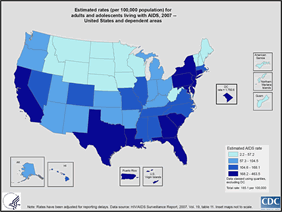
Slide 4
Estimated rates (per 100,000 population) for adults and adolescents living with AIDS, 2007 — United States and dependent areas
PDF
File
 or
PPT
File or
PPT
File |
|
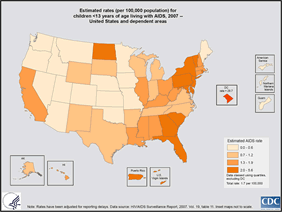
Slide 5
Slide 5: Estimated rates (per 100,000 population) for children <13 years of age living with AIDS, 2007 — United States and dependent areas
PDF
File
 or
PPT
File or
PPT
File |
|
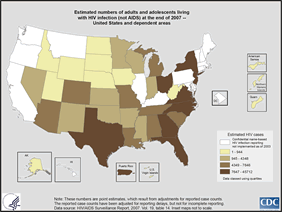
Slide 6
Estimated numbers of adults and adolescents living with HIV infection (not AIDS) at the end of 2007 — United States and dependent areas
PDF
File
 or
PPT
File or
PPT
File |
|
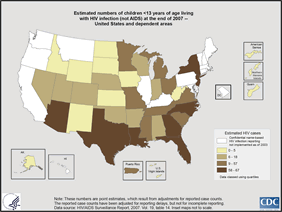
Slide 7
Estimated numbers of children <13 years of age living with HIV infection (not AIDS) at the end of 2007 — United States and dependent areas
PDF
File
 or
PPT
File or
PPT
File |
|
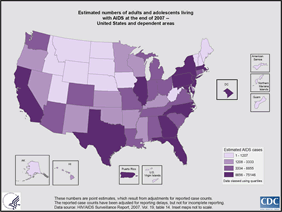
Slide 8
Estimated numbers of adults and adolescents living with AIDS at the end of 2007 — United States and dependent areas
PDF
File
 or
PPT
File
or
PPT
File |
|
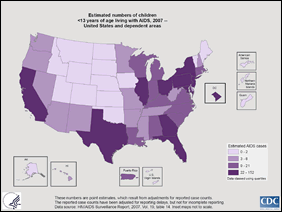
Slide 9
Estimated numbers of children <13 years of age living with AIDS at the end of 2007 — United States and dependent areas
PDF
File
 or
PPT
File or
PPT
File |
|

Slide 10
Reported AIDS cases (adults and adolescents), by metropolitan statistical area of residence, cumulative through 2007, n = 862,954 — United States and Puerto Rico
PDF File
 or
PPT
File or
PPT
File |
|
|
|
|